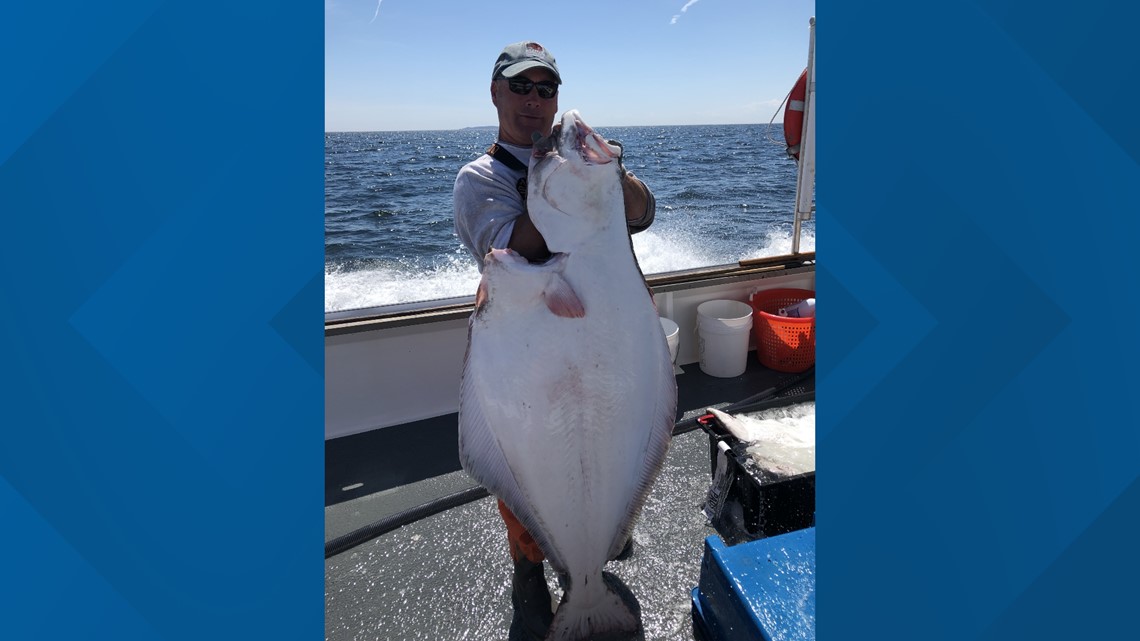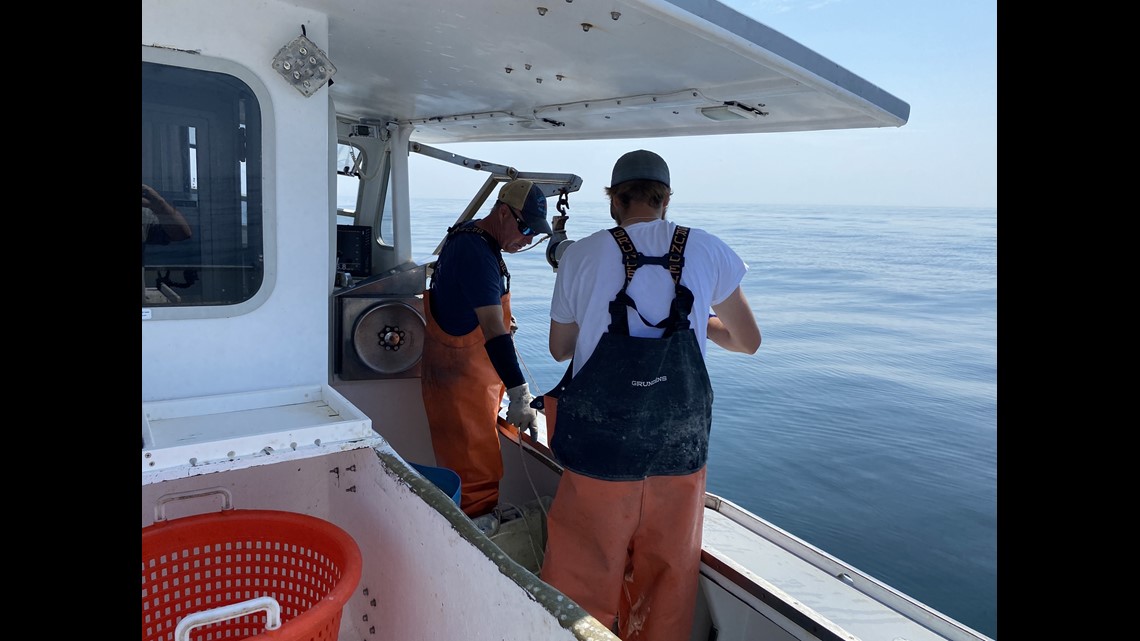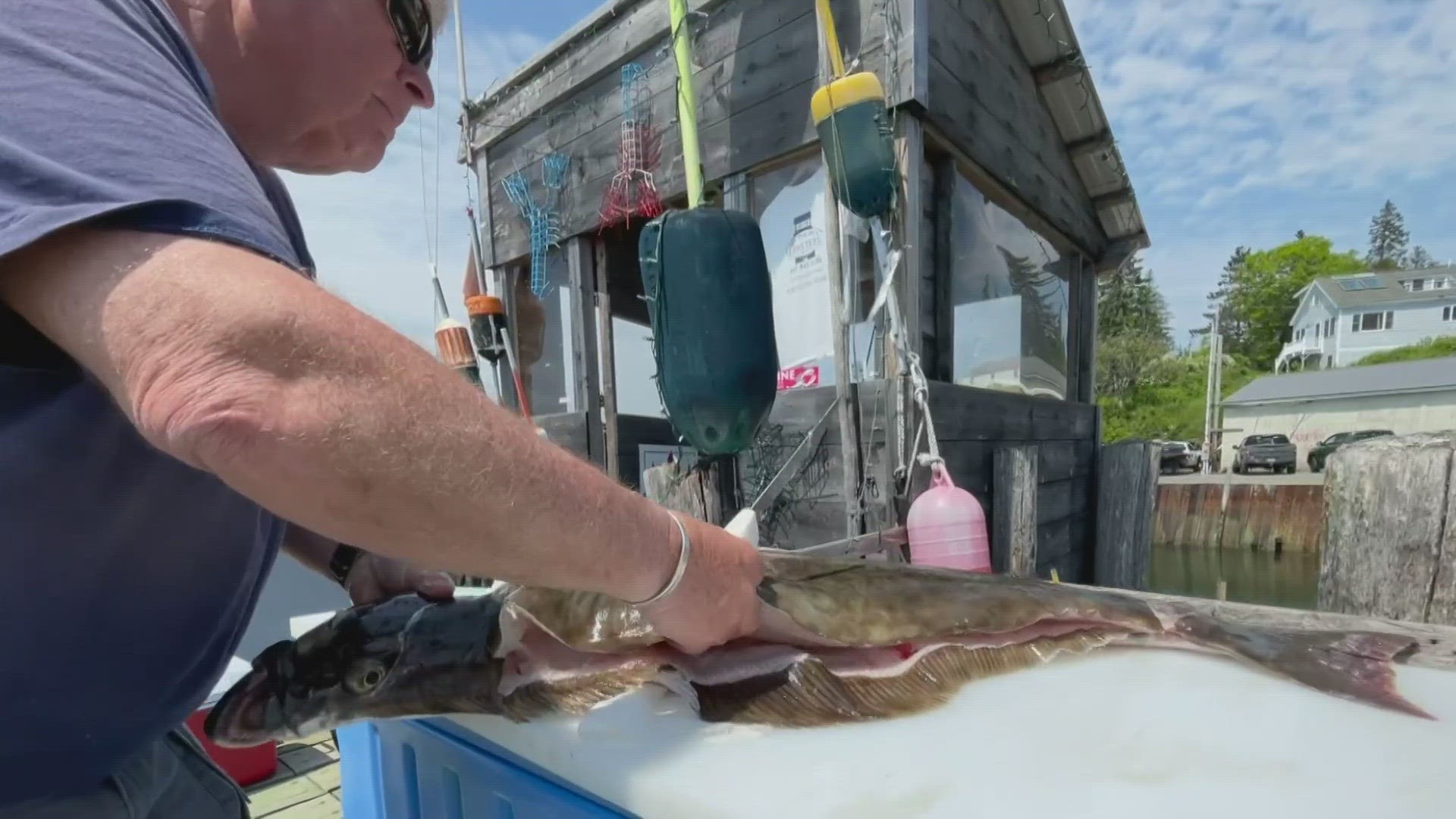ST GEORGE, Maine — The lobster boat "Bug Catcha" leaves the co-op dock in Port Clyde and heads to sea, but there are no bait barrels on board for this trip. And no lobsters will be hauled aboard, either. That part of the day’s work is already done.
This time, lobsterman Gerry Cushman and his sternman, Ethan, have their hopes on a very different catch: halibut.
The large, bottom-swelling fish have been caught along the Maine coast for centuries. They’re prized by restaurants and fish markets and, of course, by consumers. And they typically are only caught in Maine at this time of year.
"I love catching halibut," Cushman said, as he checks his electronics to find the spots beyond the state's three-mile limit where he set his lines the day before.
Halibut in Maine are usually fished by lobster boats, but there are no traps. The fish are caught the same way they have been for generations, using long lines of baited hooks, hundreds of feet long, that sit on the bottom of the ocean waiting for a halibut to bite. Cushman is fishing in what is called federal waters, outside the three-mile limit, where a federal permit is required.
Those fishing in either federal or state waters can only keep a halibut that is at least 41 inches long. The fish can grow much larger than that and can weigh a hundred pounds, sometimes twice that.
It makes hooking a big halibut a thrill that Cushman likens to hunting.
"Gets your heart beating. Like deer hunting, see a big buck, boom, boom, boom," Cushman said, slapping his chest.
And, he shows video clips from halibut caught the last several years—big, heavy fish hauled onto the deck.
The hunt is complicated by federal and state regulations. Cushman's federal permit only allows him to keep one fish per day. By contrast, those fishing in state waters, inside the three-mile limit, can keep any they catch that are more than 41 inches. Those on the state waters can only fish halibut in May and June, while Cushman can try to catch them anytime.
He added there are three types of federal permits, and his requires either a special observer on board or the use of special electronic monitoring on the boat—cameras and computers that feed information back to federal regulators on where and when he catches fish. Cushman also has to alert the regulators in advance when he plans to make a trip to fish halibut
The Atlantic halibut are caught primarily in the Gulf of Maine and off the coast of Canada. The listing for the fish on the NOAA website states that halibut are considered overfished, but some fishing is still permitted in federal waters. Maine allows commercial halibut fishing in state waters, but New Hampshire and Massachusetts do not, according to Bill DeVoe, the lead halibut researcher for the Maine Department of Marine Resources.


DeVoe said new methods of tracking the fish underwater are showing that halibut move back and forth between the Gulf of Maine and the deep ocean waters off the coast of Nova Scotia. He said the fish may be detected off Canada in the winter, where they are believed to spawn in those waters, but then return to the Gulf of Maine in spring and summer. In fact, he said, some of those halibut have been tagged in Maine one year and then caught again in the same area one or two years later.
Canada has a more active commercial fishery for halibut and allows fishermen to keep halibut larger than 34 inches.
DeVoe said they have learned a lot in the past six or seven years about the fish's travels, but that there is still a lot researchers are waiting to discover. The state is gradually extending its array of underwater listening devices, which he said will help provide more information by tracking fish with implanted electronic tags. Canada, he said, has an extensive network of acoustic monitors, which have helped track fish from Maine.
None of this means there is a large halibut population in the Gulf of Maine.
Annual landings reports from commercial fishermen show the numbers have declined over time. In the 1950s, those landings averaged around 110,000 pounds per year. In the past 10 years, the catch has averaged about 57,000 pounds. However, DeVoe said as they learn more about halibut, there is evidence suggesting populations of the fish may be increasing, though the impact of climate change and other factors aren’t clear.
That doesn’t help our luck on this trip on the "Bug Catcha." Like all fishing, it’s a matter of both skill and chance whether a big halibut will grab his hook or turn it down. And on this day, Gerry Cushman’s lines come up mostly empty. The big ones weren’t biting. Only a few small halibut come up and one of those had already been half-eaten by seals.
Cushman is disappointed but takes it in stride.
"You’re not in it for the money," Cushman said. "I’m not in it for the money, you don’t steam all the way out here for the money … this is a hobby."
Those who fish state waters, Cushman said, can make some money because they can keep much more fish—if they get them. Cushman’s friend Chris Anderson had good luck a relatively short distance away in state waters, catching two legal halibut, weighing 34 and 36 pounds. Those were both going to be sold, bringing him a decent payday. They were the first two legal halibut Anderson had caught after starting halibut fishing last year.
"I’m hooked," Anderson said with a short laugh, as the storm clouds and wind began to move in. "Soon as this weather goes by, I’ll be out again."
Gerry Cushman said he, too, was ready to head back out once the bad weather cleared.
Catching lobsters pays the bills. Catching big halibut, as Cushman said, gets the heart pounding.



